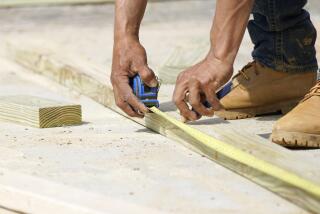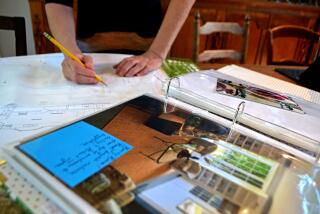Weigh Upheaval as Well as Value of Major Upgrade
- Share via
Question: We have a 1,650-square-foot home in the College Acres area of Woodland Hills and are wondering if it makes sense for us to add onto and upgrade it or save our money for our next house.
A few details: the house was built in 1952 and is smaller than most of the neighboring homes, but it sits on a half-acre lot on a hill, completely private, with a view. We bought the home for $232,000 five years ago with a 30-year loan at 6 7/8%. We have put in central air and heat, new plumbing and wood floors and have updated the kitchen. It was recently appraised at $380,000.
We have a 10-month-old baby, and we plan on having another child in a year or so, and we may want to move to a better school district in a few years.
If we do the remodel, an architect suggested we do it in stages. First, we would add a dining room, enlarge the kitchen to include a family room, which would involve turning the garage into living space. In the second stage, we would enlarge the bedrooms. If we decide not to move, we would do the third stage, which is to add a guest house and pool.
Most of the homes in our area that are selling for $450,000 to $500,000 have dining rooms, living rooms, master suites, either pools or guest houses and are about 2,500 square feet.
So the question: Do we bite the bullet and build and enjoy the larger space for the next three years? Or do we live in it, making minor repairs, such as exterior paint, better shower doors, etc., for three to four years?
SUSAN and BRYAN MATTOCKS
Woodland Hills
Answer: Your quandary shows how perplexing home improvement decisions can get. What you paid for your house, at what interest rate, the direction the neighborhood’s headed and your personal plans for the future must be considered long before someone asks you that most difficult of remodeling questions: What’s your budget?
As to whether you should undertake a major remodel when you plan on moving in a few years, it depends on your tolerance or taste for chaos. How do you feel about four to eight months of hammers, saws, dust and strangers tromping through your house? Believe it or not, some people thrive on the energy and creativity a remodeling project brings into their lives. It could be fun. But if you want your home to remain a sanctuary of peace, quiet and privacy, especially with a baby on the way, you might want to pass on the remodel.
To get a financial take on your situation, I asked the opinion of Glen Pickren, an expert in analyzing the economic feasibility of remodels. But first, Pickren, president of Barron Financial Services in Irvine, wanted a few more details: What kind of roofing (composite shingle), windows (wood) and exterior siding (stucco)? How much is owed on the mortgage? ($199,000) And what are the major cross streets? (Winnetka Avenue and Oxnard Boulevard.)
To begin, Pickren researched the neighborhood, which is a World War II subdivision with large lots from 10,000 to 25,000 square feet, or from a little less than a quarter acre to a little more than half an acre. He then looked up the “comps,” which in this case are properties in the neighborhood that are of similar size to the larger house you envision, with similar amenities, which have recently sold. A few comps are listed below:
According to Pickren, your property “should be at the upper end of the range because of its larger lot size, view and modernization.” He then estimated how much equity you have in your house and how, if invested into a remodel, it would affect your home’s value. In his opinion, you would come out $45,000 ahead with such a remodel.
Without commenting on your specific plan, Pickren cautions against turning the garage into living space. Because the home has a raised foundation, “if the existing garage slab is retained, the step down may make it look like a cheap remodel, which will not give you the $500,000-plus value,” Pickren explained. “If the garage floor is raised, then the walls and ceiling will be too low.”
This, he said, could put you in the classic remodeling mistake of designing your remodel around garage walls that will have to be removed and rebuilt in the end.
Plus, Pickren suggests skipping the detached guest house and pool. Instead of an equity gain as shown above, these improvements generally add no more than half their cost in value. For homes in this price range, it is usually best to incorporate a guest house into the home so that it is counted as part of the living area instead of an out-building.
Pickren also advises against doing a major remodel in stages because, he said, it can cost more that way. However, I’ve seen other families remodel their homes in stages, with very good results.
Pickren offers more tips on his company’s Web site: https://www.dreambuilder.net.
Don’t do this: Don’t do a major remodel on a home you plan to sell in a few years unless you have the stomach for months of noise, dust and lack of privacy.
Do this: If you’ll enjoy the excitement of a remodel, and a feasibility study indicates that the value of your home will increase more than the cost of the remodel, go for it.
*
Kathy Price-Robinson is a freelance writer who has written about remodeling for 10 years. She can be reached at: kathyprice@aol.com.
*--*
Address Lot Size Sq. Ft. Bed/Bath Sales Price 19985 Oxnard St. 13,040 2,696 4/2.75 $545,000 6029 Penfield Ave. 23,500 2,723 3/3 $580,000 5900 Oakdale 18,170 2,099 4/3 $510,000
*--*
*--*
Before After Sq. Ft. 1,650 2,650 Est. Value $380,000 $550,000 Est. Cost $125,000 Mortgage $199,000 $199,000 Equity Line $125,000 Loan N/A $125,000 Equity $181,000 $231,000 Gain/(Loss) N/A $45,000
*--*
More to Read
Sign up for Essential California
The most important California stories and recommendations in your inbox every morning.
You may occasionally receive promotional content from the Los Angeles Times.






